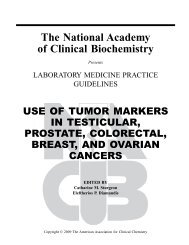oCtoBeR 2010 - American Association for Clinical Chemistry
oCtoBeR 2010 - American Association for Clinical Chemistry
oCtoBeR 2010 - American Association for Clinical Chemistry
You also want an ePaper? Increase the reach of your titles
YUMPU automatically turns print PDFs into web optimized ePapers that Google loves.
detecting il-2 and ifn-γ<br />
discriminates between active<br />
and latent Tb infection<br />
new research indicates that detecting<br />
interleukin-2 (IL-2) in addition<br />
to interferon-γ (IFN-γ) discriminates active<br />
from latent Mycobacterium tuberculosis<br />
infection (Clin Microbiol Infect<br />
<strong>2010</strong>;16:1282-1284). The research builds<br />
diagNostiC<br />
22 CliniCal laboratory news <strong>oCtoBeR</strong> <strong>2010</strong><br />
p r o f i L e s<br />
p r o f i L e s<br />
on recent studies demonstrating the utility<br />
of assays that measure IFN-γ release in<br />
blood cells stimulated with M. tuberculosis<br />
antigens, according to the authors. IFN-γ<br />
release assays accurately diagnose tuberculosis<br />
(TB) infection, but do discriminate active<br />
from latent TB.<br />
The researchers stimulated whole blood<br />
with M. tuberculosis-specific antigens and<br />
used the QuantiFERON-TB Gold In Tube<br />
test to measure IFN-γ release and a commercially<br />
available ELISA assay to measure<br />
IL-2 release after 18 and 72 hours of incubation.<br />
The specimens came from patients<br />
hospitalized in an infectious diseases unit<br />
and from control subjects without known<br />
exposure to TB. Participants also underwent<br />
tuberculin skin testing (TST); those<br />
with positive test results and positive M.<br />
tuberculosis culture from sputum were considered<br />
to have active TB. Latent infection<br />
was defined as positive tests in exposed individuals<br />
with no signs of active disease.<br />
The investigators found that subjects<br />
with either latent or active TB had significantly<br />
higher levels of IFN-γ than controls.<br />
However, IFN-γ levels between individuals<br />
If you want to be known as an expert,<br />
you have to become an expert. AACC’s<br />
online certificate program is the way.<br />
““<br />
• <strong>Clinical</strong> Laboratory Leadership and Management<br />
• Laboratory Support <strong>for</strong> Diabetes Testing<br />
• Point-of-Care Specialist<br />
• Basic Principles and Architecture of Laboratory<br />
In<strong>for</strong>mation Systems<br />
• Fundamentals of Molecular Pathology<br />
• Statistical Methods <strong>for</strong> <strong>Clinical</strong> Laboratorians<br />
• Using Tandem Mass Spectrometry in the<br />
<strong>Clinical</strong> Laboratory<br />
To learn more and enroll, visit<br />
aacc.org and click on “Events,”<br />
then “Online Education.”<br />
7<br />
Online Learning<br />
Certificate Programs<br />
from<br />
CLN_online_cert_jnr_isl_ad_7x10.indd 1 7/16/10 12:44:07 PM<br />
with latent or active TB were not significantly<br />
different at 18 or 72 hours after incubation.<br />
In contrast, after 72 hours’ incubation,<br />
IL-2 levels were significantly higher<br />
in patients with latent TB infection than either<br />
active TB or healthy controls. The area<br />
under the receiver operator characteristic<br />
curve was 0.99, and a threshold of 2.0 U/<br />
mL yielded a sensitivity of 90% and specificity<br />
of 97.5%.<br />
The authors speculate that the increased<br />
levels of IL-2 observed in latent TB infection<br />
likely reflect more IL-2 secreting and<br />
IL-2/IFN-γ-secreting central memory Tcells<br />
along with fewer IFN-γ-secreting effector<br />
memory T-cells in individuals with<br />
latent as opposed to active TB.<br />
bnp levels do not predict<br />
intracranial hemorrhage in<br />
pediatric Trauma patients<br />
researchers at Children’s Hospital Los<br />
Angeles found that B-type natriuretic<br />
peptide (BNP) levels measured during an<br />
emergency visit do not predict intracranial<br />
hemorrhage (ICH) in pediatric trauma<br />
patients (J Trauma <strong>2010</strong>;68:1401–5). They<br />
conducted the study to determine whether<br />
BNP might help identify children most in<br />
need of computed tomography (CT) scans.<br />
Emerging evidence indicates there is a significantly<br />
increased risk of cancer among<br />
pediatric patients who have CTs, and protocols<br />
to deploy CT more selectively have<br />
been implemented. At the same time,<br />
emerging evidence suggests that BNP levels<br />
are elevated in adults with head injuries.<br />
Since BNP tests are readily available and<br />
can be per<strong>for</strong>med quickly, the researchers<br />
hypothesized that this analyte might predict<br />
ICH and help guide physicians in determining<br />
whether a CT would be needed.<br />
They enrolled 100 consecutive pediatric<br />
patients presenting at the emergency<br />
department who were classified as Level I<br />
trauma status with the most critical injuries<br />
and physiologic parameters. However,<br />
of 95 patients who remained in the study<br />
<strong>for</strong> analysis, they did not find a relationship<br />
between BNP levels and the presence<br />
of various trauma injury measurements<br />
such as injury severity score, Glasgow coma<br />
scale, or loss of consciousness. In fact, BNP<br />
levels <strong>for</strong> 57.9% of patients were below the<br />
assay’s lower limit of detection, and mean<br />
BNP levels among patients in the positive<br />
ICH group were slightly less than those<br />
who were negative <strong>for</strong> ICH.<br />
While the researchers conclude that<br />
based on their study, BNP levels are not<br />
clinically relevant to predict CTs with positive<br />
results <strong>for</strong> ICH, they underscored that<br />
specimens drawn <strong>for</strong> the study were taken<br />
only upon arrival at the emergency department.<br />
However, evidence in adults indicates<br />
that BNP levels in aneurysm and subarachnoid<br />
hemorrhage did not rise significantly<br />
until hours or days later. The authors suggest<br />
that further investigation of pediatric<br />
BNP levels outside the emergency setting is<br />
warranted.<br />
visit aacc.org
















